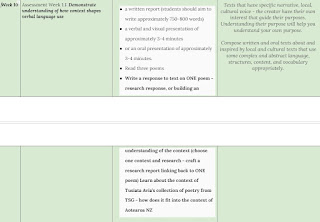The new curriculum refresh is fast approaching. The official launch will take place at the beginning of the school year in 2024. As a department, we started our journey with the new curriculum refresh in May 2022. You can find my reflections on the journey that I have taken with my colleagues in my posts below.
Our NCEA Level 1 English Course is at a stage where it is aligned with the new curriculum refresh. We have decided on the theme of the course, the learning that we want to deliver from through the theme and the assessments that we are going to offer our students. I have started to plan and design a unit for the two new internal assessments that we are offering our Level 1 students for Level 1 English 2024. In this post I am going to share and reflect on the planning process and what our next steps are.
1.1: 91924Demonstrate understanding of how context shapes verbal language use
In November 2022, we looked at this standard. To understand and get familiar with the standard we focused on the following areas:
- What is the assessment?
- What are the key words/concepts of the assessment?
- What are the opportunities with this assessment?
- What are the potential barriers for kaiako with this assessment?
- What are our next steps?
- Unpacking the three activities provided by NCEA
By breaking it down, we were able to get our head around the standard. Please refer to the post - Alby's Blog Entry Post - 13/11/22 - to see how this went for our department. Since then I have taken learning from this conversation and the learning from design of our NCEA Level 1 Course and started a unit plan. My plan is centered around three areas, I will explain each area and what I have done with them.
PART ONE: Learning Intention
 |
| Learning intention and description for 1.1:91924 |
The learning intention and description for this unit is:
TERM 1: Our Stories + Our History (mirrors)
In this unit we will learn about our stories and our histories by focusing on the poetry of Tusiata Avia.
We’ll learn about how language and literature are unique taonga that give us insights into ourselves and others in Glen Innes, and we’ll practice using our voices to tell our own stories. We’ll end with an assessment where we show off what we’ve learned about how language in poetry works depending on who, where, and when we are.
The learning intention and description is important. It helps to set the tone, expectation and hopefully inspire my colleagues and students. Traditionally, our unit plans are heavily centered around the assessment. The course description of our current NCEA Level 1 English program uses the language associated with the assessment. I wanted to make sure that the description for our new internal assessment is both meaningful and exciting to the learning that is going to happen in the unit. I wanted to pull some of the stuff that I wrote from the overall course description and connect the learning from this unit with the big picture learning from the course.
PART TWO: Defining the three key areas of the unit
There are three key areas of the unit. They are - Focus, Action and Learning Goal. Each area gives both kaiako and akonga a clear understanding on what the learning intention is, what we are going to do with it and how it aligns with the curriculum refresh. I will explain each area below.
 |
| Focus, Action + Learning Goal for 1.1:91924 |
- Focus: This simply outlines what the focus is for the week or time period. It is clear for both kaiako and akonga what they will be looking at.
- Action: The action is the 'learning'. Here I have outlined what they will be doing with the focus area and it explains the formative assessments that we could cover.
- Learning Goal (linking to the Significant Learning and UDK - Understand, Know and Do - from Te Mataiaho: The Refreshed New Zealand Curriculum): Linking the focus and action to the significant learning and UDK is integral, as it helps to narrow the learning priority for each phase of the unit. Another step that I would like to start experimenting with is to rewrite the UKD and significant learning so that it is more directly relevant to the unit. This is something that I would like to do especially when we start to roll out each unit for both assessments.
PART THREE: Outlining the learning
 |
| Learning outline for 1.1: 91924 |
Planning out the sequence of learning has been fun. I have been intentional in making sure that the reading and exploration of the text for this unit is at the forefront. I have integrated formative assessment throughout the unit so that there are opportunities for our students to craft different text types, as a seigway into the assessments (both internal and external) but also as an opportunity for them to enjoy the crafting of a text. Typically we reserve half our program to the assessment (usually a 5 week window for the assessment). For this unit, I have reserved 3 weeks for the assessment and the first 7 weeks will be solely dedicated to the text, unpacking and exploring the social context around the text and learning how this context helps to shape and create meaning.
NEXT STEPS:
- Continue to collaborate with the English Department - looking forward to our TOD where we can edit, amend and refine the program so that it makes sense for us as kaiako and also for our students.
- Exploring the text - discuss our primary text and see what other opportunities we can pull from this and integrate it into the unit.
- Reflection - Reflect and review the primary text for 1.1:91924 Tusiata Avia's 'The Savage Coloniser'




No comments:
Post a Comment